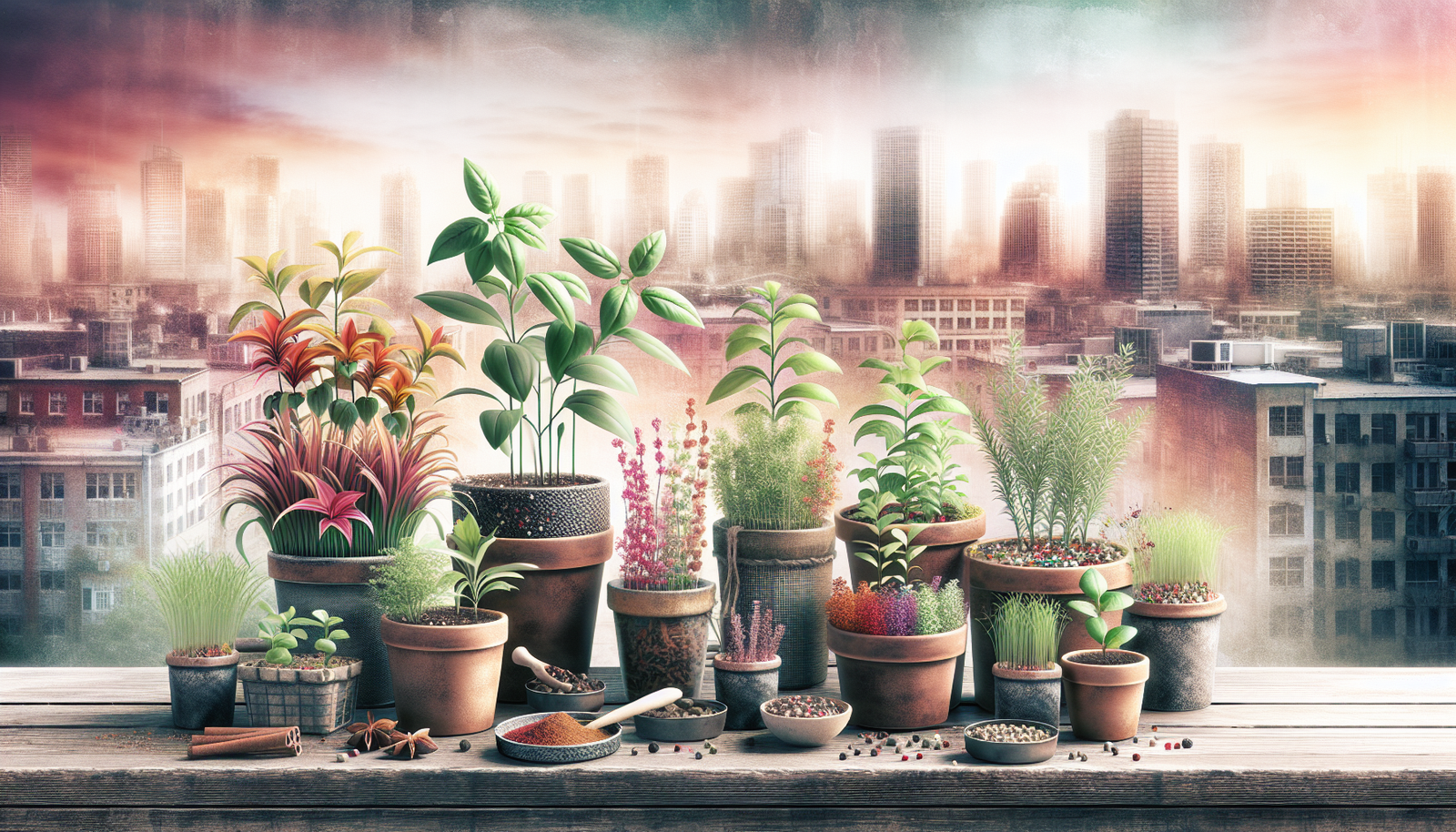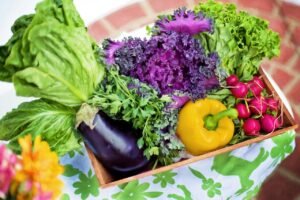
Are you a city dweller with a passion for fresh herbs and spices? If so, you might be wondering how to cultivate your very own thriving urban spice garden in the limited space of your small apartment or windowsill. Fret not, because we have got you covered! In this article, we will explore creative and practical tips to help you transform your urban space into a aromatic haven, full of flavorful herbs and spices just waiting to enhance your culinary creations. So, grab your gardening gloves and let’s get started on this exciting journey to create a mini oasis of flavor right in your own home!
Choosing the Right Containers
When creating an urban spice garden, it’s crucial to choose the right containers to ensure the plants have enough space to grow and thrive. Consider the size and depth of the container when making your selection. Some spices have deeper root systems and require larger containers, while others can do well in shallower ones. It’s important to give each plant sufficient room for its roots to spread out.
In addition to size, opt for containers with good drainage. Proper drainage is essential to prevent waterlogging and root rot. Look for containers with drainage holes at the bottom to allow excess water to escape. This will help maintain the right moisture levels for your plants and prevent waterlogged soil.
Lastly, consider using containers with handles for easy mobility. Urban gardening often means making the most of limited space, so having the ability to move your containers around is beneficial. You may need to shift them to catch more sunlight or protect them from extreme weather conditions.
Selecting the Ideal Location
The location of your urban spice garden plays a significant role in its success. Identify a sunny spot for your containers. Most spice plants thrive in full sun, so choose a location that receives at least six hours of direct sunlight per day. If you’re limited on available sunny spots, prioritize areas that receive morning sunlight as this is usually the most beneficial for plant growth.
Consider the temperature and humidity of the chosen location. Different spices have different preferences when it comes to these factors. Some spices thrive in warmer temperatures, while others prefer cooler climates. Similarly, some spices prefer higher humidity levels, while others require drier conditions. Research the specific requirements of the spices you intend to grow and select a location that aligns with their needs.
Evaluate the accessibility for watering and maintenance. Make sure the location is easily accessible for regular watering and maintenance tasks. Having the containers within reach will make it more convenient for you to monitor the plants and provide the care they need.
Starting with the Right Soil
Choosing the right soil for your urban spice garden is vital for the plants’ overall health and growth. Opt for a well-draining potting mix that allows excess water to flow through. A well-draining soil helps prevent water stagnation, which can lead to root rot and other moisture-related issues.
It’s also beneficial to mix in organic matter to enrich the soil and provide added nutrients. Organic matter, such as compost or well-rotted manure, enhances the soil’s fertility and provides essential minerals for plant growth. Incorporating it into the potting mix will promote healthier and more vigorous spice plants.
Consider the pH levels of the soil as well. Different spices have varying pH preferences, with some preferring slightly acidic soil, while others thrive in neutral or alkaline conditions. Research the pH requirements of the spices you plan to grow and adjust the soil accordingly to provide the optimum pH levels.
Picking the Perfect Spice Varieties
Selecting the right spice varieties for your urban container garden is crucial for success. Determine which spices you commonly use in your cooking or enjoy the most. By growing your favorite spices, you’ll have the satisfaction of using fresh, home-grown ingredients in your dishes.
Consider the growth requirements of each spice when making your selection. Some spices prefer full sun, while others can tolerate partial shade. Some require a specific temperature range to thrive, while others can withstand a wider range of climates. Take into account the specific needs of each spice and choose those that are well-suited to your local conditions and the available space in your containers.
Additionally, choose compact and dwarf varieties when growing spices in small containers. These varieties are specifically bred to be more manageable and take up less space. Their compact size makes them ideal for urban gardening, where space is often limited.
Sowing Seeds or Transplants
When starting your urban spice garden, you have the option to sow seeds or use transplants. Each method has its advantages, so consider which approach suits your preferences and circumstances.
Starting from seeds is a cost-effective approach. Seeds are readily available and often more affordable than purchasing mature plants. Sowing seeds also allows you to have a wider variety of spice options as you can easily find a vast selection of seeds. However, it requires more time and patience as you’ll need to wait for the seeds to germinate and grow into mature plants.
Opting for transplants offers faster results. Transplants are young plants that have already started growing, so you’ll have a head start compared to growing from seeds. They are relatively easy to find at nurseries or garden centers. However, transplants may limit your spice variety choices as there may be a more limited selection compared to seeds.
Providing Adequate Watering
Watering is a crucial aspect of maintaining a thriving urban spice garden. Water your plants consistently, but be careful not to overwater them. Overwatering can lead to root rot and other moisture-related problems. It’s better to let the soil slightly dry out between waterings rather than keeping it excessively damp.
Check the moisture levels regularly by inserting your finger about an inch into the soil. If it feels dry at that depth, it’s time to water. If it still feels slightly moist, hold off on watering for a little longer. The frequency of watering depends on various factors such as the weather conditions, container size, and the specific requirements of the spices you’re growing. Monitor your plants and adjust the watering frequency accordingly.
During hot and dry weather, your plants may need more frequent watering, while cooler and rainy periods may require less watering. Be mindful of the climate and adjust your watering routine accordingly.
Ensuring Proper Light Exposure
Spices thrive when they receive adequate light exposure, so it’s crucial to place your containers in a sunny location. Aim for at least six hours of direct sunlight per day, but more is often better. When selecting a spot, ensure there are no obstructions like tall buildings or trees that may cast shadows over your containers.
To promote even light distribution, it’s beneficial to rotate your containers regularly. Spices tend to grow towards the light, and rotating the pots ensures that all sides of the plants receive adequate light. This helps prevent lopsided growth and encourages uniform growth throughout the plant.
If your chosen location doesn’t receive enough sunlight or if you’re growing spices indoors, supplementing with artificial grow lights can be beneficial. LED grow lights are energy-efficient and provide the necessary spectrum of light for plant growth. Position the lights at an appropriate distance from the plants to mimic the intensity of sunlight.
Fertilizing for Growth and Flavor
To promote healthy growth and enhance the flavor of your spice plants, proper fertilization is essential. Use a slow-release organic fertilizer when planting your spices. Slow-release fertilizers provide a steady supply of nutrients over a more extended period, ensuring a consistent source of nourishment for your plants.
Additionally, apply liquid fertilizers periodically during the growing season to provide an extra boost of nutrients. Liquid fertilizers are quickly absorbed by the plants and can help address any nutrient deficiencies that may arise. Follow the instructions on the fertilizer packaging for the recommended application rates and frequency.
Avoid over-fertilizing, as excessive nutrients can lead to imbalanced growth and compromise the taste of your spices. It’s essential to strike a balance and provide the right amount of nourishment without overloading the plants.
Pruning and Harvesting Techniques
Pruning is a necessary part of maintaining a thriving urban spice garden. Regularly trim your plants to promote bushier growth and prevent them from becoming straggly or leggy. Pruning encourages the development of more side branches and helps create a fuller, more compact plant.
When it comes to harvesting, it’s best to pick the leaves when they are young and tender. Young leaves tend to have a more robust and vibrant flavor. Regularly harvest leaves from your spice plants to encourage continuous growth. Be mindful not to remove more than one-third of the plant’s foliage at a time, as this may stress the plant and affect its overall health.
Each spice may require different pruning techniques, so it’s important to familiarize yourself with the specific guidelines for each plant. Research the appropriate methods for pruning each spice and apply them accordingly to maintain healthy growth.
Preventing Pests and Diseases
Keeping your containers clean and free from debris is the first line of defense against pests and diseases. Regularly remove any fallen leaves or dead plant material to prevent the accumulation of pests or pathogens. Good sanitation practices can help reduce the risk of infestations and diseases.
Monitor your plants regularly for signs of pests or diseases. Look out for any visible damage to the leaves, stems, or flowers, as well as any unusual spots or discoloration. Early detection is crucial in preventing the spread of pests and diseases. If you notice any issues, take immediate action to address them.
When necessary, use organic pest control methods to protect your spices. There are various natural remedies such as insecticidal soaps, neem oil, and plant-based repellents that can effectively control pests without harming the environment or your plants. Research organic pest control methods suitable for the specific pests affecting your spices and use them as needed.
By following these tips and guidelines, you can create a thriving urban spice garden in small containers or windowsills. Enjoy the satisfaction of growing your own fresh and flavorful spices right at home, adding a delicious touch to your meals. Happy gardening!





